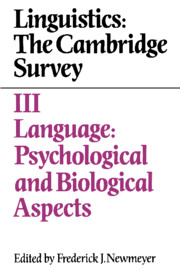Book contents
- Frontmatter
- Contents
- Contributors
- Preface
- 1 Psycholinguistics: an overview
- 2 Language and cognition
- 3 Processes in language production
- 4 Language perception
- 5 The mental lexicon
- 6 Where learning begins: initial representations for language learning
- 7 Second language acquisition
- 8 Neurolinguistics: an overview of language–brain relations in aphasia
- 9 The biological basis for language
- 10 Linguistics and speech–language pathology
- 11 The evolution of human communicative behavior
- 12 Linguistics and animal communication
- Index of names
- Index of subjects
- Contents of Volumes I, II, and IV
11 - The evolution of human communicative behavior
Published online by Cambridge University Press: 03 February 2010
- Frontmatter
- Contents
- Contributors
- Preface
- 1 Psycholinguistics: an overview
- 2 Language and cognition
- 3 Processes in language production
- 4 Language perception
- 5 The mental lexicon
- 6 Where learning begins: initial representations for language learning
- 7 Second language acquisition
- 8 Neurolinguistics: an overview of language–brain relations in aphasia
- 9 The biological basis for language
- 10 Linguistics and speech–language pathology
- 11 The evolution of human communicative behavior
- 12 Linguistics and animal communication
- Index of names
- Index of subjects
- Contents of Volumes I, II, and IV
Summary
the capacity to communicate by symbols and syntax does lie within the ape's grasp. Many zoologists now doubt the existence of an unbridgeable linguistic chasm between animals and man.
(Wilson 1978: 26)It seems reasonable to assume that evolution of the language faculty was a development specific to the human species long after it separated from other primates.
(Chomsky 1979: 36)Introduction
There are two classes of nontrivial questions in science: those that are in principle answerable and those that are not. Most questions discussed in this volume belong to the former category, although one might argue that some, such as the instantiation of language in the brain, may lie beyond our rational powers (cf. Chomsky 1968: 78–9). The question addressed in this chapter, however, belongs to the second category, and that being the case, one might reasonably ask why consider it at all. Indeed, as is well known, the Société de Linguistique de Paris passed a by-law in 1866 banning all consideration of the origin of language.
If there were no framework available for investigating the evolution of complex behaviors such as human communication, and furthermore, if we lacked any empirical data base relevant to such an investigation, we might indeed be inclined to support what Stam (1976) refers to as the ‘annihilation of the question.’ However, as can be seen from Table 1, we do not lack data upon which to base our investigations.
- Type
- Chapter
- Information
- Linguistics: The Cambridge Survey , pp. 274 - 313Publisher: Cambridge University PressPrint publication year: 1988
- 1
- Cited by

